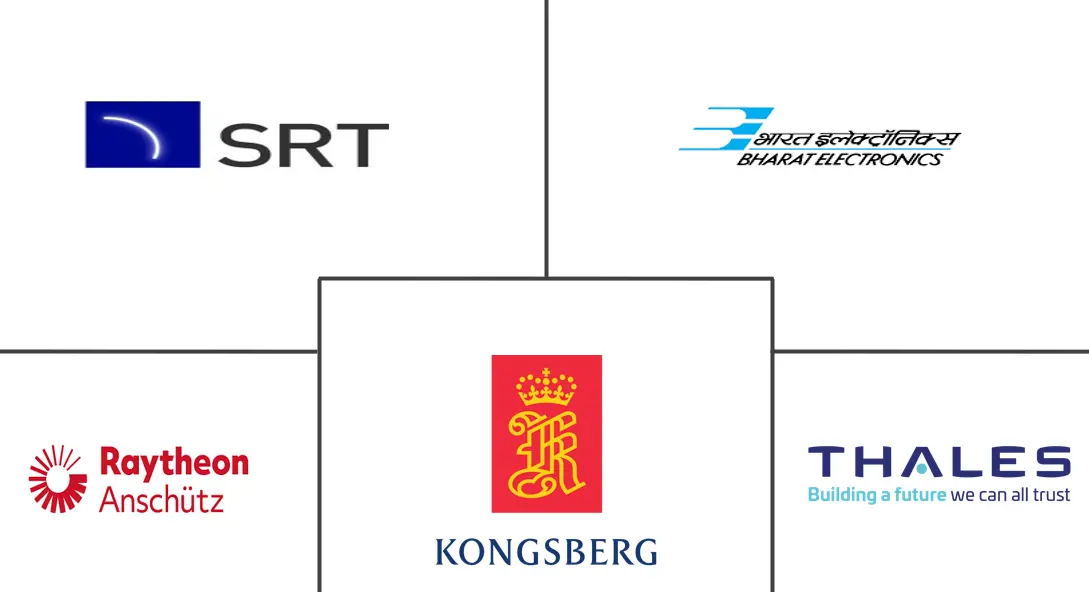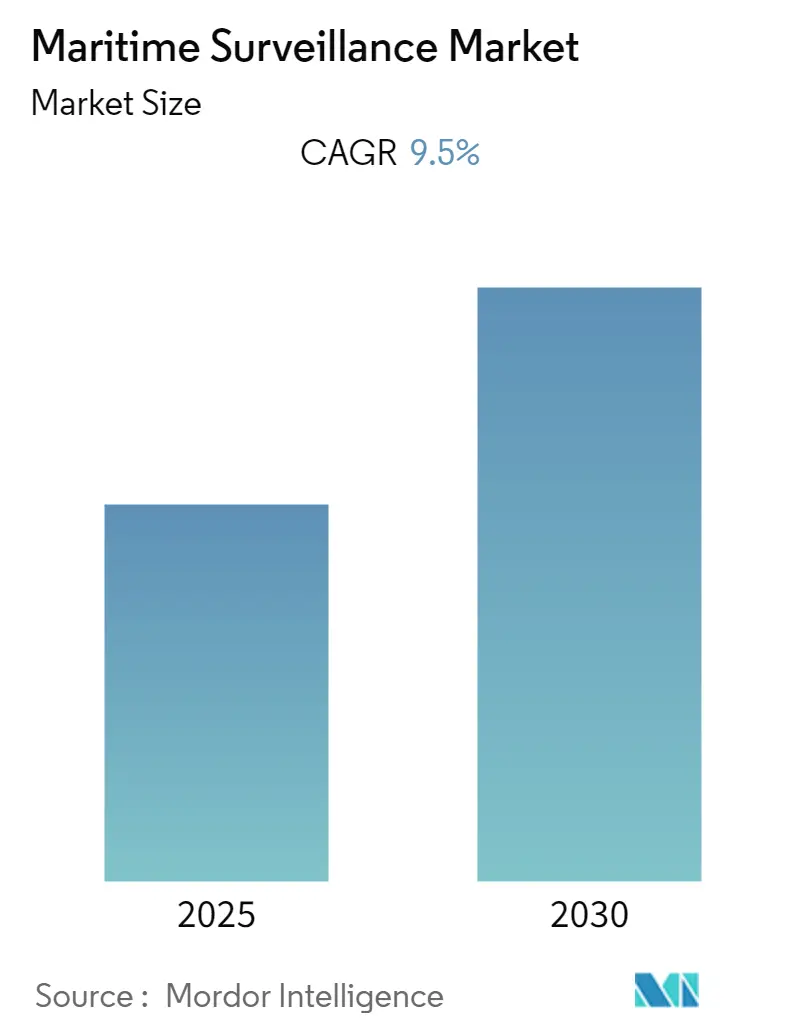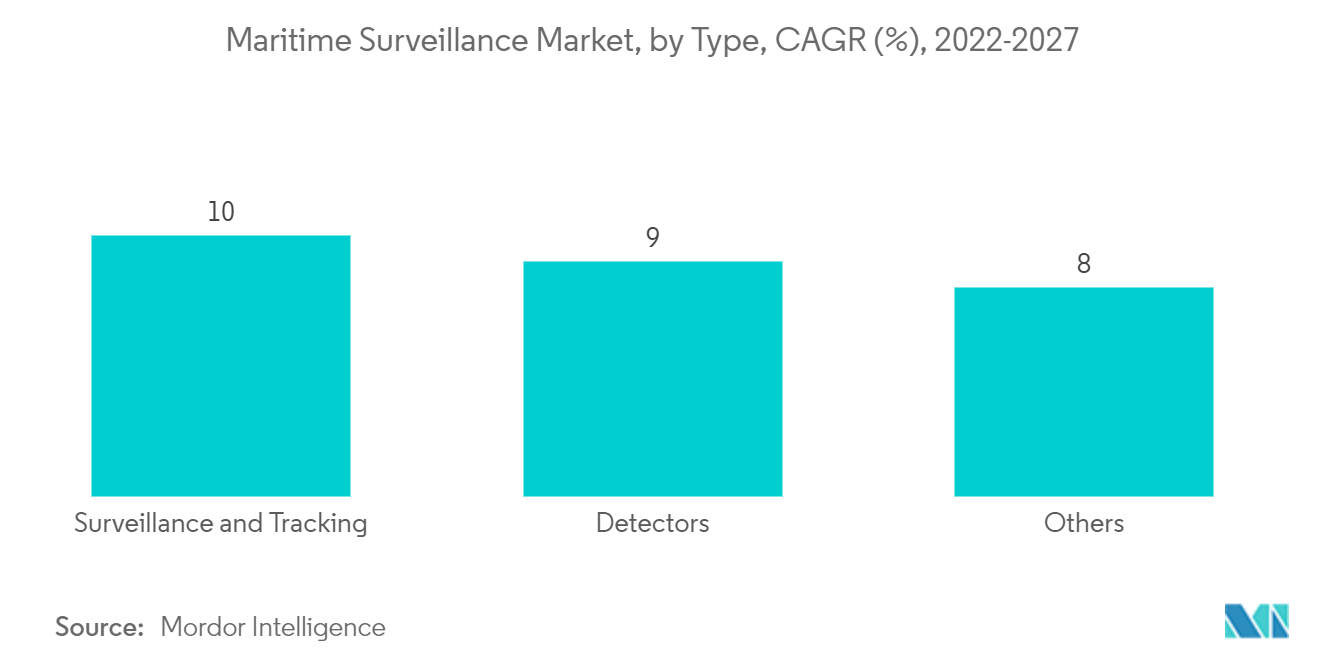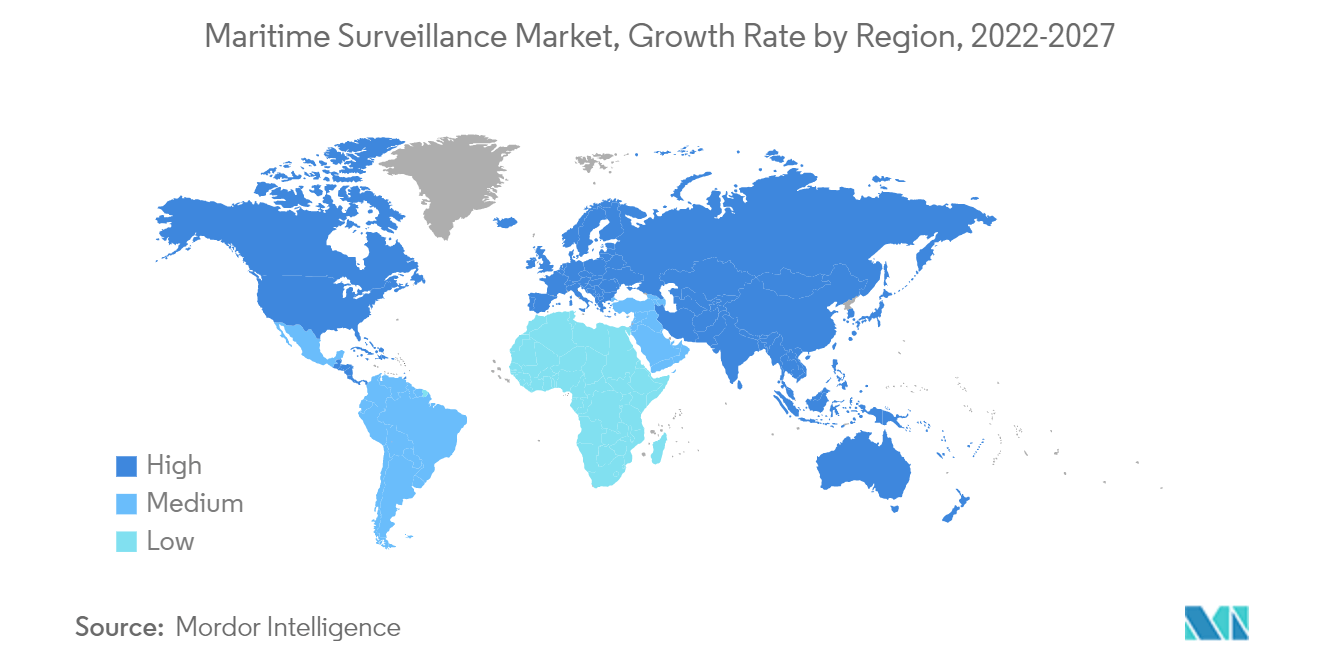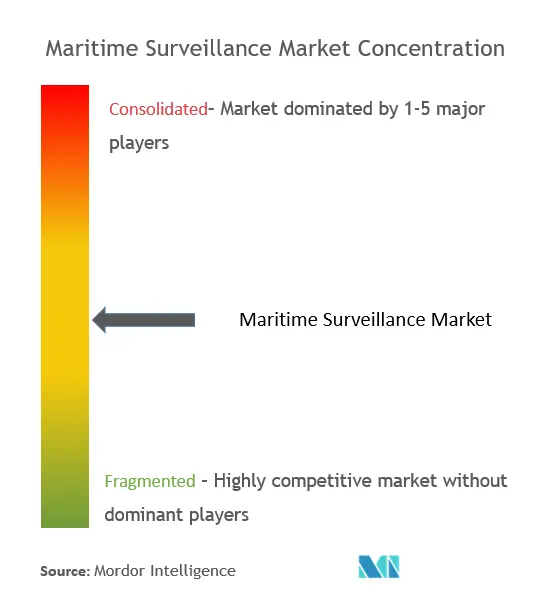Maritime Surveillance Market Analysis
The Maritime Surveillance Market is expected to register a CAGR of 9.5% during the forecast period.
The COVID-19 pandemic has had a negative effect on the maritime surveillance market. The pandemic led to various governments around the world imposing stringent regulations and banning the import and export of raw materials, which led to a sudden downfall regarding the valuable parts needed for the manufacturing of maritime surveillance systems. Additionally, manufacturers in various nations were forced to shut down their businesses wholly or partially due to the global lockdown. Furthermore, the pandemic also led to delays in terms of activities as well as initiatives concerning the development of advanced maritime surveillance systems. The decline in the COVID-19 pandemic led various governments worldwide to ease up on the stringent regulations which were in place and open up the borders, which led to a free flow of trade and availability of raw materials, parts, and components for manufacturers to resume production and meet the increasing maritime surveillance procurement demand. Thus, this will lead to the market growing steadily in the years to come.
The maritime traffic worldwide is expected to grow due to global sea trade. The growth in seaway transportation has led to expansion in the presence of various trader vessels at sea, which has increased the number of oceanic criminal activities in recent years. These challenges have prompted nations worldwide to develop and upgrade their surveillance and intervention solutions to prevent criminal activities. This will lead to the market witnessing growth in the long run.
Maritime Surveillance Market Trends
Surveillance and Tracking Segment is Expected to Witness Significant Growth During the Forecast Period
The surveillance and tracking segment is expected to witness significant growth during the forecast period owing to various tracking software to monitor the location and give necessary alerts to protect vessels, ports, and other shipping infrastructure.
The rising number of maritime threats, including piracy, has led various nations worldwide to upgrade their technologies regarding maritime surveillance and tracking capabilities. Surveillance in a maritime environment is indispensable in fighting against a wide range of criminal activities, including pirate attacks and unlicensed fishing trailers. Various systems such as computer vision can be a helpful aid in the law enforcement process, for example, tracking and identifying moving vessels on the ocean. A robust maritime system also needs to differentiate between artificial structures on the sea and animal life. It also needs to be capable of tracking multiple targets through various occlusions. All of these requirements influence the choice of surveillance methodology.
In addition, with the rising need for maritime security at ports and in coastal areas, in areas such as Russia, LATAM, and the Caribbean, where the occurrence of piracy attacks and robberies has surged rapidly over the past few years, the requirement for these devices is projected to be significant. Various nations in the North American and the European region are now adopting cutting-edge maritime security technologies using a wide range of cameras, including infrared, fisheye, and pan-tilt-zoom (PTZ) cameras. Thus, such advancements will lead to growth in the market during the forecast period.
Asia-Pacific is Expected to Witness Significant Growth During the Forecast Period
The Asia-Pacific region is expected to witness significant growth during the forecast period. The key driving factor behind this growth is an increasing need to detect maritime hazards and ensure communication with all the available officials across the maritime sector with advanced software.
For the past few years, China has not been an active player in maritime security; on the other hand, in 2021, China used civilian vessels to carry out maritime surveillance operations. With the creation of the "Spratly Backbone Fleet" program by the Chinese government, China is increasing the number of vessels being used for maritime surveillance activities, with about 300 to 400 vessels being deployed at any given time. In addition to about 800 to 1,000 commercial fishing boats in the Spratly fleet, China has approximately 200 other vessels as part of a professional maritime militia. Moreover, China has been increasing its submarine deterrent patrols to ensure they can map the underwater terrain and carry out surveillance activities. In addition, Japan is also investing in enhancing its maritime capabilities, and it plans to acquire and realign intelligence, surveillance tracking, and reconnaissance (ISR) assets to sensitive areas, upgrade naval patrol craft, ground force radars, and missile units, and develop amphibious assault capability within a joint JSDF task force. Thus, such developments will lead to significant growth in the maritime surveillance market in Asia-Pacific during the forecast period.
Maritime Surveillance Industry Overview
Some of the most prominent players in the Maritime Surveillance Market are SRT Marine Systems PLC, Kongsberg Gruppen, Bharat Electronics, Raytheon Anschutz Gmbh, and Thales Group, among others. Various companies are now focused on growth strategies, including developing and launching new maritime surveillance products, product approvals, and patents. Moreover, an expanded product portfolio of advanced maritime surveillance solutions, as well as increased investments in R&D and strategic acquisitions, will be the key factors that will lead to these players dominating the market during the forecast period.
Maritime Surveillance Market Leaders
-
SRT Marine Systems PLC
-
Kongsberg Gruppen
-
Bharat Electronics
-
Raytheon Anschutz Gmbh
-
Thales Group
- *Disclaimer: Major Players sorted in no particular order
Maritime Surveillance Market News
- November 2022: SRT Marine Systems, a marine surveillance and coastal monitoring technology company, announced that it had signed a contract with a significant coastguard in Asia to provide an initial SRT-MDA maritime monitoring system. The contract is for a small system that would enable the coastguard to coordinate several other national agencies when identifying and to schedule vessel inspections for safety, law enforcement, and security purposes.
- October 2022: Ocean Power Technologies, a leader in innovative and cost-effective low-carbon marine data, power, and consulting service solutions, has been selected for a USD 529,025 procurement by Amentum Services. Ocean Power Technologies was awarded the procurement to assist Amentum in providing the Department of Defense (DoD) Information Analysis Center (IAC) with land, air, space, and port & coastal surveillance services in support of the U.S. Department of Homeland Security (DHS) Science & Technology Directorate (S&T).
- May 2022: The Defense Ministry of India announced a contract worth INR 887 crore with Larson & Toubro (L&T) Limited for procuring two multi-purpose vessels (MPV) for the Navy. These vessels, to be built by L&T shipyard at Kattupally (Chennai), will perform multi-role support functions such as maritime surveillance and patrol, launching/ recovery of torpedoes, and operation of various types of aerial, surface, and underwater targets for gunnery, Anti-Submarine Warfare (ASW) firing exercises.
Maritime Surveillance Industry Segmentation
Maritime surveillance involves the collection, analysis, data fusion, and sharing of data. The information is captured through a wide variety of sensors and sensor combinations operating in various segments of the spectrum (electronic signals, imagery, communications, and acoustics, amongst others.
The report has been segmented by application, component, type, and geography. By application, the market is segmented into naval, coastguard, and others. The market is segmented by components: radar, sensor, transponder, and others. By type, the market is segmented into surveillance and tracking, detector, and others. By geography, the market is segmented into North America, Europe, Asia-Pacific, Latin America, and the Middle East and Africa. The report also covers market sizes and forecasts of different geographical regions. Moreover, the report offers a market forecast represented by USD million. Furthermore, the report includes various key statistics on the market status of leading market players and provides key trends and opportunities in maritime surveillance.
| By Application | Naval | ||
| Coastguard | |||
| Other Applications | |||
| By Component | Radar | ||
| Sensor | |||
| Transponder | |||
| Other Components | |||
| By Type | Surveillance and tracking | ||
| Detectors | |||
| Other Types | |||
| By Geography | North America | United States | |
| Canada | |||
| Europe | Germany | ||
| United Kingdom | |||
| France | |||
| Rest of Europe | |||
| Asia-Pacific | China | ||
| India | |||
| Japan | |||
| Australia | |||
| Rest of Asia-Pacific | |||
| Latin America | Mexico | ||
| Brazil | |||
| Middle East and Africa | United Arab Emirates | ||
| Saudi Arabia | |||
| South Africa | |||
| Rest of Middle East and Africa | |||
Maritime Surveillance Market Research FAQs
What is the current Maritime Surveillance Market size?
The Maritime Surveillance Market is projected to register a CAGR of 9.5% during the forecast period (2025-2030)
Who are the key players in Maritime Surveillance Market?
SRT Marine Systems PLC, Kongsberg Gruppen, Bharat Electronics, Raytheon Anschutz Gmbh and Thales Group are the major companies operating in the Maritime Surveillance Market.
Which is the fastest growing region in Maritime Surveillance Market?
Asia-Pacific is estimated to grow at the highest CAGR over the forecast period (2025-2030).
Which region has the biggest share in Maritime Surveillance Market?
In 2025, the North America accounts for the largest market share in Maritime Surveillance Market.
What years does this Maritime Surveillance Market cover?
The report covers the Maritime Surveillance Market historical market size for years: 2019, 2020, 2021, 2022, 2023 and 2024. The report also forecasts the Maritime Surveillance Market size for years: 2025, 2026, 2027, 2028, 2029 and 2030.
Our Best Selling Reports
Maritime Surveillance Industry Report
Statistics for the 2025 Maritime Surveillance market share, size and revenue growth rate, created by Mordor Intelligence™ Industry Reports. Maritime Surveillance analysis includes a market forecast outlook for 2025 to 2030 and historical overview. Get a sample of this industry analysis as a free report PDF download.

